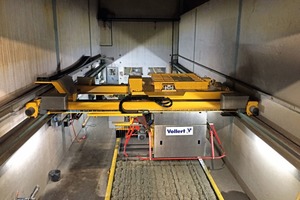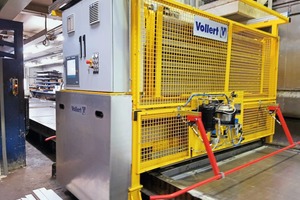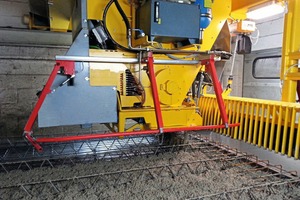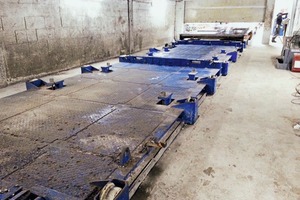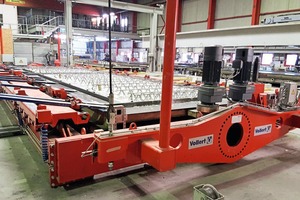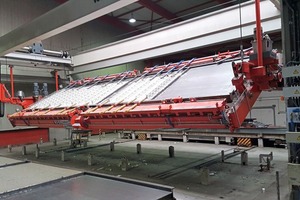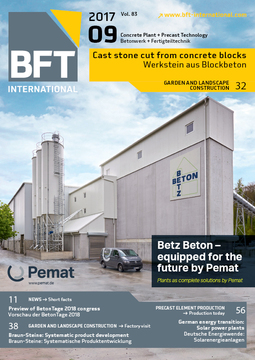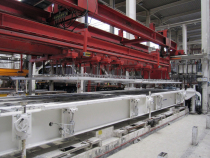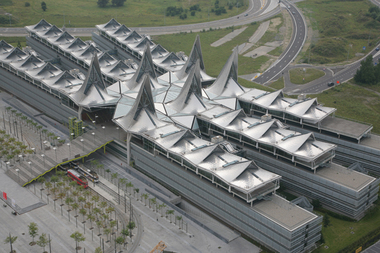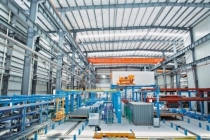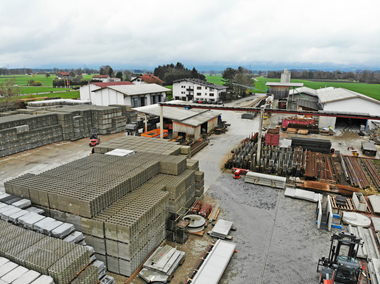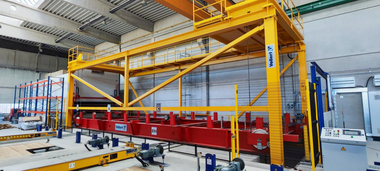Modernization improves product quality and increases plant productivity
The plant equipment of many precast concrete factories originates from the 1990s and is based on the knowledge of that time. Rising cost pressures and more and more varied requirements necessitate new technologies.
Economically high output capacities and a permanently high level of quality, even if wall and floor elements are produced in the shortest time and according to customized specifications – these are the requirements which manufacturers of precast concrete elements have to meet today in order to remain competitive in the competition for customers and contracts. Machine technology and the processes in the production of precast concrete elements have to follow these trends.
Retrofit – the modernization or the extension of existing plant equipment – is the decisive catchword. “At present, we modernize precast concrete plants Europe-wide and across the world,” states Markus Schenk, Project Manager Sales and Service at the machinery and equipment specialist Vollert. The latest project examples show how modern automatic concrete spreading systems or high-performance pallet turning units can realize cost-saving potentials in the short run.
Plant equipment from the 1990s
“Gebr. Kaltenbach GmbH & Co. KG, the raw material supplier and manufacturer of building products based in Dronstetten, is a perfect example of how tradition and innovation go well together through permanent modernization measures,” Schenk says. Since 1923, Gebr. Kaltenbach have been active in extracting crushed stone and gravel from their own quarry in the northern part of the Black Forest, using these for the production of asphalt and ready-mixed concrete. Since the 1990s, apart from structural precast concrete elements such as staircases and balconies, the company has been manufacturing precast floor slabs according to customer specifications and double walls in various sizes and shapes. “As part of several modernization steps we now retrofit the more than 20-year-old plant equipment to state-of-the-art technology,” says Werner Wößner, Technical Manager - Precast Concrete Production at Gebr. Kaltenbach.
The concrete placing process is a crucial factor for the quality of the finished walls and floor slabs. “In December of 2016, the entire concrete placing process was retrofitted and the manual concrete spreader installed in 1988 was replaced by an ultra-modern CAD/CAM-controlled automatic concrete distributor of Vollert,” Wößner states. The Smart Cast automatic concrete distributor provides for homogenous and precise casting of the concrete. “In this way, we save up to 10 % of concrete in comparison to the past. This really exceeded our expectations,” Wößner says.
Concrete spreading system
retrofitted in just two weeks
The existing track of the concrete distributor could be maintained. The machine control system was expanded so as to integrate the new automatic concrete distributor into the control system. An optimum traversing program has been created for each subsequent concreting process. Screw discharge units provide for concrete proportioning, with the screw drive being activated individually or in groups in automatic mode. Screw caps provide for clean discharge. A rotating distribution roller avoids the formation of material cones and ensures an optimum concrete flow towards the discharge. The screw discharge unit is frequency controlled, i.e. infinitely variable, to enable an adjustment of the discharge volume to different concrete consistencies.
The concrete discharge amount is permanently digitally captured and controlled. Intelligent laser systems are used for the path measurement in longitudinal and transverse direction. The position is transferred to the automatic control system with millimeter precision. An additional roughening unit provides for roughing of the surface in a time-saving way, ensuring a uniformly roughened surface. Now, up to four precast floor slabs pass the concrete placing process per hour. The changeover time of the overall retrofit took just two weeks and took place during the Christmas break in 2016.
Fdu Group aiming at high quality
MÜVA Beton located in Holzminden also intends to increase the plant productivity of the precast floor slab production by means of a new CAD/CAM controlled Smart Cast automatic concrete distributor. MÜVA Beton is part of the fdu Group, being the biggest supplier in Germany with an annual capacity of 8.7 million m² of precast concrete slabs and 1.6 million m² of wall elements, according to their own statement.
“Modernization is a permanent topic for us,” says Benno Strack, MES Manager. “The new automatic concrete distributor enables us to increase the quality of our floors slabs in Holzminden considerably, while reducing the concrete output.” Optimum traversing and discharge programs as well as path measurement in longitudinal and transverse direction with the aid of an intelligent laser system ensure cost savings.
Compacting energy exactly adjustable
In addition to this, the vibration station installed in the 1990s was replaced by a modern low-frequency Smart Compact2 vibration station of Vollert. This strongly reduces the high level of noise resulting from usual compacting procedures of fresh concrete. The desired compacting energy can be adjusted exactly. It is moreover possible to process much stiffer concrete grades. “The new compaction station has an extremely flat design, which required only floor recesses in the section of the unbalance drive due to a circulation height of 320 mm,” Vollert Project Manager Schenk states.
Magazining of the transverse formwork was also completely modernized. A newly installed MCP unit not only takes the transverse formwork from the circulation pallet and stores it in magazines, but also cleans the pallet surface from concrete and adhesive residues by means of roller brushes and side rail brushes and applies the release agent. From the traveling magazine, the high-precision gripping system, that is CAD/CAM controlled, places the transverse formwork for the next precast concrete element. The magnets are closed automatically through a pneumatic activation system. In addition, the contours for the longitudinal formwork and embedded parts are plotted using water-soluble paint. “Vollert has replaced all three components in a very short time to our utmost satisfaction,” states Strack, the Project Manager Concrete at MÜVA.
Efficient double-wall
production at BE Beton-Elemente
To optimize the workflows of the double-wall production and to adjust them to the requirements prevailing in today‘s construction industry, particular attention is above all paid to the turning equipment in case of retrofit projects. BE Beton-Elements located in the Southern German town of Steißlingen, being active in manufacturing of sophisticated walls and floor slabs for almost 70 years, is now modernizing the section of the double-wall production. The main focus in this respect will be on the VArio Turn pallet-turning equipment.
“Sometimes we produce very complex wall elements with different part geometries and heights, with and without insulation. Therefore, the clear objective for the modernization of the existing turning equipment was to obtain the maximum machine productivity in the production of high-quality double-walls with smooth surfaces on both sides,” says Dietmar Notz, Technical Plant Manager at BE Beton-Elemente.
Turning beam with increased holding power
The newly installed turning technology provides an increased holding power allowing for the manufacture of a wide variety of different walls besides rising output rates. For this purpose, the complete turning beam was replaced, and the automation system was modernized being brought into line with the new technology. Before the turning process, the circulation pallet is hydraulically locked in the turning beam at first. Pneumatically locked tensioning arms make sure that the upper shell of the double wall is securely held on the turning beam during the lifting and turning motion. Load capacities of up to 10 tons are possible.
“The tensioning arms of the stop side are slidable and fixed by means of shoes and Halfen channels and remain permanently mounted on the turning beam. This eliminates the extensive manual assembly and disassembly of the tensioning arms before and after the turning process, respectively,” Vollert manager Schenk says. “Thus, the new tensioning arm system of Vollert provides for a clear cost advantage.” Wall spacers allow for the production of double walls from 180 up to 400 mm.
Retrofit – A sustainable trend
The information is transferred from the master computer to the turning beam. Then, the spacers automatically adjust to the wall height required. The new turning beam is additionally equipped with automated height adjustment in order to manufacturer core-insulated double walls. For this purpose, the pneumatic tensioning unit is mounted to a substructure that is adjustable in height with a maximum lift of 160 mm. The adjustment to the overall wall height is also carried out fully automatically by CAD/CAM control.
“The examples demonstrate how latest machine technology can realize cost saving potentials in the short run. With our modernization program, we provide precast concrete factories with an effective answer to today‘s building trends and the rising cost pressures,” Vollert Project Manager Schwenk concludes.

